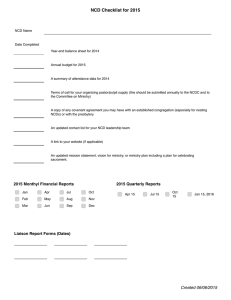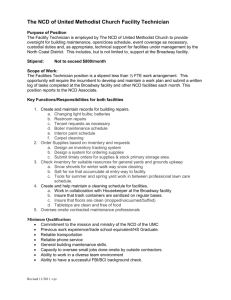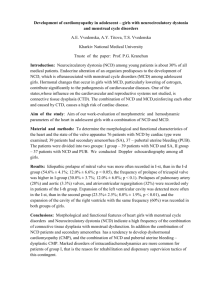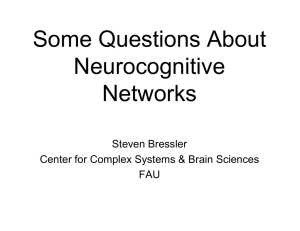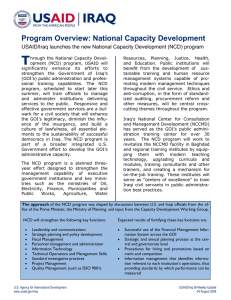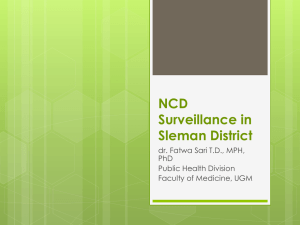Neurocognitive Disorders of the DSM-5
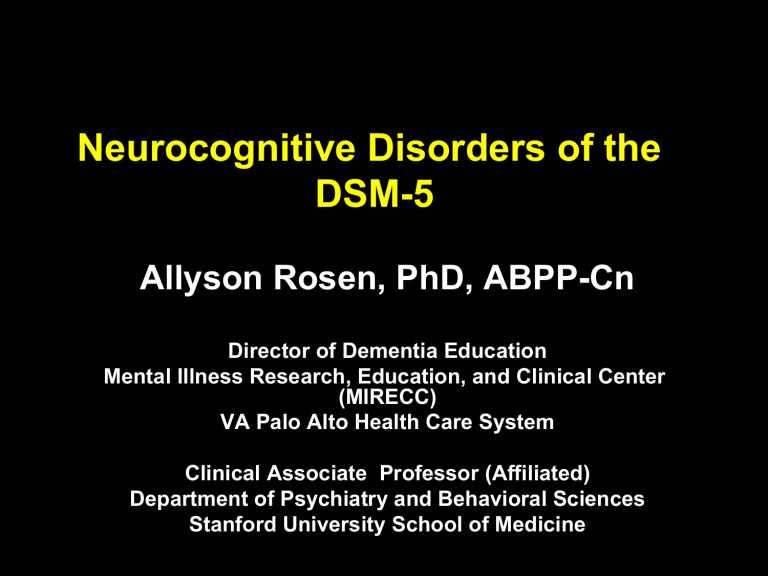
Neurocognitive Disorders of the
DSM-5
Allyson Rosen, PhD, ABPP-Cn
Director of Dementia Education
Mental Illness Research, Education, and Clinical Center
(MIRECC)
VA Palo Alto Health Care System
Clinical Associate Professor (Affiliated)
Department of Psychiatry and Behavioral Sciences
Stanford University School of Medicine
Speakers
• Allyson Rosen
• Ruth O’Hara
• Maya Yutsis
• Brian Yochim
• Geoff Kerchner
Neurocognitive Disorders
• Delirium
• Major and Mild Neurocognitive
Disorder (NCD)
Neurocognitive Disorders (NCD)
• Primarily COGNITIVE disorders
• Acquired and represent decline
(i.e. not developmental)
Neurocognitive Disorders
• Primarily COGNITIVE disorders
• Acquired and represent decline
(i.e. not developmental)
• Underlying brain pathology
• For degenerative disorders monitor consensus guidelines in addition to DSM 5
Updates on Neurocognitive
Disorders????
Updates on Neurocognitive
Disorders????
NO
We can still be
Updates on Dementia
Neurocognitive Disorders (NCD) vs.
Dementia
• Dementia typically refers to degenerative d/o in elderly
Neurocognitive Disorders (NCD) vs.
Dementia
• Dementia typically refers to degenerative d/o in elderly
• DSM expands category to d/o of younger
– E.g. HIV, traumatic brain injury
Major and Mild
Neurocognitive Disorders
(NCD)
Major NCD
• Significant Cognitive Decline
• Interfere with independence
• Not due to delirium
• Not due to other mental disorder
Major NCD vs. Dementia
• Can be single domain
– E.g. Amnestic
– Exception: Major NCD due to
Alzheimer’s disease.
Major NCD
• Significant Cognitive Decline
• Interfere with independence
• Not due to delirium
• Not due to other mental disorder
Mild NCD
• Moderate Cognitive Decline
• NOT Interfere with independence
• Not due to delirium
• Not due to other mental disorder
Mild NCD
• Like mild cognitive impairment
• Previously:
Cognitive Disorder
Not Otherwise Specified
Major and Mild
Neurocognitive Disorders
• Cognition: Psychometric Definition
Mild vs Major NCD
Cognitive Testing
• Mild: 1–2 standard deviation (SD) range
(between the 3rd and 16th percentiles)
• Major: Below 2 SD or 3 rd percentile
Test Scores
Test Scores
MAJOR
MILD
Mild vs Major NCD
Cognitive Testing
• Mild: 1–2 standard deviation (SD) range
(between the 3rd and 16th percentiles)
• Major: Below 2 SD or 3 rd percentile
• These should not be rigidly used! Consider premorbid level, sensitivity of tests etc.
• Major and Mild exist on a continuum
Cognitive domains specified
DSM-5:
• Complex attention
• Executive function
• Learning & memory
• Language
• Perceptual-motor
• Social cognition
DSM-IV:
• Memory impairment
• Aphasia
• Apraxia
• Agnosia
• Executive dysfunction
Other Descriptors
• Possible vs Probable
• Behavioral Disturbance:
– With: e.g. psychosis, mood, agitation
– Without (not clinically significant)
• Severity (level of disability)
– Mild: Instrumental ADL’s are preserved
– Moderate: Basic ADL’s affected
– Severe: Fully dependent
Types of Neurocognitive Disorders
• Delirium
• Major and Mild Neurocognitive
Disorder (NCD)
Major and Mild Neurocognitive
Disorder (NCD)
NCD due to:
Alzheimer’s disease
Vascular disease
Traumatic Brain Injury
Lewy body disease
(several others)
Other NCDs
Neurocognitive Disorders of the DSM-5
Neurocognitive Disorders of the
DSM-5
Delirium
Traumatic Brain Injury
Maya Yutsis, PhD
Clinical Neuropsychologist
Polytrauma Transitional Rehabilitation Program
VA Palo Alto Health Care System
Delirium
Differential Diagnosis of Delirium
• Major Neurocognitive Disorder
• Delirium due to a General Medical
Condition
• Substance Intoxication Delirium
• Substance Withdrawal Delirium
• Delirium due to Multiple Etiologies
• Delirium NOS
Delirium Differs from other NCD
• Rapid Onset in hours to days
• Linked to Medical Condition,
Substance Intoxication/Withdrawal,
Medications, other causes
• May resolve completely
• Symptom length:
– Acute - hours to days
– Persistent -weeks to months
Delirium Diagnostic Criteria
• Key Features: Rapid and Abrupt onset of:
– Impaired Attention
– Lack of Awareness of environment
• Change in at least ONE Cognitive Domain:
– Recent Memory
– Orientation
– Language (i.e. rambled speech, mumbling, difficult to understand)
– Perceptual Disturbance
• Associated Features
– Change in sleep-wake cycle
– Change in emotional states
– Worsening of behavioral problems in the evening
NCD due to
Traumatic Brain Injury
Mild NCD due to TBI
• Mild NCD
– Cognition: 3-16 %ile
– Functional Independence: Mild decline but not impaired*
• Onset: Medically documented history of TBI
(at least 1 of the criteria):
– Loss of consciousness
– Post-traumatic amnesia
– Confused and disoriented immediately after the event
– Neurological/Neuroimaging evidence, not required
• Symptom Course
– Immediate onset following TBI or after recovering consciousness
– Persist past acute post-injury periord
– Any cognitive domain involvement
– Recovery Trajectory: partial or complete
– Weeks to months
*may need assistance but not fully dependent on others
Major NCD due to TBI
• Major NCD
– Cognition: <3%ile
– Functional Independence: Impaired
• Onset: Medically documented history of TBI
(at least 1 of the criteria):
– Loss of consciousness
– Post-traumatic amnesia
– Confused and disoriented immediately after the event
– Neurological/Neuroimaging evidence, IS required
• Symptom Course
– Immediate onset following TBI or after recovering consciousness
– Persist past acute post-injury periord
– Any cognitive domain involvement
– Recovery Trajectory: partial or complete
– Weeks to months
Neurocognitive Disorders of the
DSM-5
NCD Associated with
Lewy Body Disease
Allyson Rosen, PhD, ABPP-Cn
NCD due to LBD
• NCD
• Onset: Insidious
• Core symptoms
– Fluctuating cognition/attention/alertness
– Visual hallucinations-well formed and detailed
– Parkinsonian movement develops 1 year
AFTER cognitive impairment
• Suggestive features
– Rapid eye movement (REM) sleep disorder
– Neuroleptic sensitivity
Key Issues in NCD due to LBD
• Neuroleptic Sensitivity
– Worsening of movement disorder and impaired consciousness
• Onset:
– Major NCD BEFORE motor (vs. Parkinson’s)
• Probable/Possible
– Differ in number of core and suggestive features
• Fluctuations: Existing measures
– e.g. Ferman et al., 2004; Walker et al., 2000
Beyond DSM 5
• McKeith, I. G., Dickson, D. W., Lowe,
J., Emre, M., O'Brien, J. T., Feldman,
H. et al. (2005). Diagnosis and management of dementia with Lewy bodies: third report of the DLB
Consortium. Neurology, 65 (12),
1863-1872.
Neurocognitive Disorders of the
DSM-5:
Alzheimer’s Disease
Brian Yochim, PhD, ABPP
Clinical Neuropsychologist
Mental Illness Research, Education, and Clinical Center (MIRECC)
VA Palo Alto Health Care System
Clinical Assistant Professor (Affiliated)
Department of Psychiatry and Behavioral Sciences
Stanford University School of Medicine
Major or Mild NCD due to
Alzheimer’s disease (AD)
• Insidious onset & gradual progression
• Major NCD: 2 or more cognitive domains impaired (unlike other Major
NCDs) + impaired IADLs
• Mild NCD: 1 or more cognitive domains impaired, IADLs intact
“Probable” vs. “Possible”:
AD genetic mutation
• “Probable” vs. “Possible” are differentiated in part by presence of
Alzheimer’s disease gene.
• This can be from family history or formal genetic testing.
Major NCD due to AD
• Probable AD: either one must be present:
• Evidence of AD genetic mutation, or
• All 3 of the following:
– Impairment in memory + 1 other domain
– Progressive, gradual decline
– No other possible etiology
• Otherwise, Possible AD is diagnosed
Mild NCD due to AD
• Probable AD: requires evidence of
Alzheimer’s gene.
• Possible AD: no evidence of AD gene, but all 3 of these factors exist:
– Decline in memory & learning
– Progressive, gradual decline
– No evidence of other etiologies.
Beyond DSM 5: MCI Reference
